
 |
|||||
|
|
|||||
|
|
|
|||||
|
|
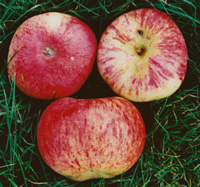 |
S.T. WRIGHT A pretty cooking apple, bred by J. Allgrove, while working at the Veitch’s Nursery at Middle Green, Langley, Buckinghamshire, which was later bought out by the Allgrove family. It dates from 1913 and was a cross between Peasgood’s Nonsuch and Bismarck. It was named after the Royal Horticultural Society’s Fruit Officer. Scions were rescued from Allgrove’s Nursery after it had gone wild by Nick Houston, who was close to the Allgrove family, before the death of Jim Allgrove and the demise of his nursery. He passed scions to us. Ripe in September, it cooks to a sweet yellow purée. Pollination Group 4 |
||
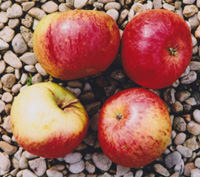 |
SAINT ALBANS PIPPIN First mentioned in 1883, it is a crisp and juicy apple with a sweet but tangy flavour. The mid-season fruit is striped red with darker red on the sunny side. Despite the name, it originally came from Kent, and not Saint Albans in Hertfordshire. Hogg said it was usually grown around Brenchley. Pollination Group 3 |
|||
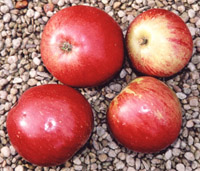 |
SAINT
CECILIA A Welsh, late dessert apple raised in Monmouthshire in
1900 from Cox's Orange Pippin, open pollinated. It was introduced by nurserymen,
Cheals of Crawley, Sussex. A delicious crisp, dessert apple which has
long been appreciated by amateur growers, especially in the west of England,
for its sweet, juicy fruit, which has a rich, intense taste. Heavy crops.
Stores until March. Pollination Group 2 |
|||
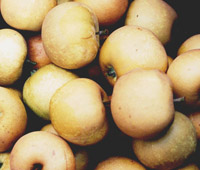 |
SAINT
EDMUND'S PIPPIN Also called St. Edmund's Russet. Raised by Mr
R. Harvey at Bury St. Edmunds in the mid 1800s, and first recorded at
the R.H.S. in 1875. A middle season dessert russet, with sweet flesh and
a rich flavour. One of the best apples for early October. Apples will
store for a month or so. Trees are upright and spreading. Pollination
Group 3 |
|||
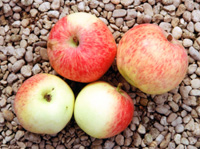 |
SAINT
FRANCIS The only record of this apple comes from Robert Furber’s
‘Twelve Months of Fruits’ - coloured engravings in 1732, with
lists of his fruits repeated in ‘A Short Introduction to Gardening….’
In 1733. The engraving suggests the apple is ripe in January, in a period
when fruits ripened later due to the Little Ice Age. Saint Francis only
appeared to exist still in America and was only in the Botner Collection,
which no longer exists, except, in part, at The Temperate Orchard Conservancy
in Oregon, where much of the apple collection was regrafted for posterity.
We obtained scions from there several years ago. Our tree first fruited
in 2022 and the apples were in accord with Furber’s plate, though
the apples here ripened in October. His plate indicated a medium to large
apple, though the scale of some of his fruits were sometimes idiosyncratic.
The first fruit here, off a young tree, was more medium sized. Quite a
pretty dessert apple, with pale yellow skin, finely streaked with amber
and scarlet, with crisp, sweet flesh and a good flavour. Pollination Group
5 |
|||
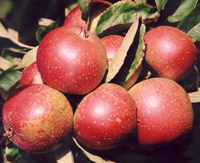 |
SAINT
MAGDALEN The name of this apple has been heavily confused by
the National Collection in recent years. The name has been moved from
Saint Magdalen, to Magdalene, then to Magdalen and now back to Magdalene.
This was despite the pre-existence of another apple called Magdalene known
in 1768 and not the same as Saint Magdalen. A Magdelaine was even known
to John Evelyn, the name dating from 1651. A Magdalen was also known in
1858 in Wales, before Saint Magdalen existed. The renaming also adds to
confusion since Magdalene has long been a synonym of both Margaret and
Madeleine. The National Apple Register (1971) included both Saint Magdalen
and Magdalene, and it seems they were the same apple. However, the name
Saint Magdalen came first – the apple having been received as Saint
Magdalen by the National Fruit Trials in 1931. Magdalen was first noted
from an exhibit at the Apple and Pear Confererence in 1934 and it was
not until 1946 that Taylor made the name Magdalene. The National Fruit
Trials as late as 1985, before they became the National Collection, still
called it Saint Magdalen. The National Collection continued to call it
the same, into the 21st century. Changing the name is illogical. This
apple was found at Magdalen, Norfolk by H. Bridge circa 1890 and introduced
by H. Goude in 1924. Morgan (The Book of Apples) gives a similar history
but says it was found at St Mary Magdalene, Norfolk. (the charity ‘Common
Ground’ say it came from the orchard of H. Bridge at Wiggenhall
St Mary, near Downham Market). The place is currently called Wiggenhall
St Mary Magdalen, though the names Magdalene and Magdalen have been used
interchangeably for two thousand years. It is a late dessert, medium sized
apple, pale green yellow, largely covered with dark red and with russet
patches and dots. The flesh is firm, fine textured, sweet and slightly
acid. It is ripe from October to December. Our thanks to John and Helen
Hempsall for sending scion wood to us. Pollination Group 3 |
|||
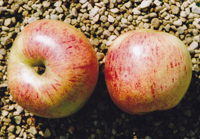 |
SAINT
JOHN’S PIPPIN In the mid 19th century, well established
orchards were close to Oxford city centre, to the north and east. The
Victorian and Edwardian expansion in housing took all their space, but
left several trees to live on in the gardens of the new houses. Some still
exist today. In North Oxford their grid planting can still be plotted,
at variance with the lines of the houses and gardens. To the East, few
old trees still exist. Just north of the centre, on the edge of the area
known as Jericho, where other old fruit trees can be found, scattered
around the Victorian gardens, once within orchards but built over to provide
housing for university servants, there is a singular old apple tree. It
is in the garden of a house built in the 1970s, within an orchard. The
owners, John and Diana Ashby, believed the tree to be around 200 years
old and in a state of decay. John brought us cuttings to graft new trees
for their garden and allotment early in the new millenium and we kept
a tree here. Sadly, John died shortly after. The road in which their house
was built, in the 1870s, was land owned by St John’s College, Oxford,
who owned much of the land at Oxford at that time, and many orchards within
it, to supply the colleges and the townsfolk. This particular tree was
named by John as Saint John’s Pippin, after the college. The apples
are ripe in early October, are medium to large and with skin of pale green,
turning pale yellow, delicately flecked with crimson. They are good eating
apples, with crisp, sweet, juicy flesh and also very good culinary apples,
baking well and cooking to a froth. Apart from the nursery catalogue of
John Gee, 1891, (later Gee’s Garden Centre on the Banbury Road)
little is known of the extent and varieties within these old orchards.
It seems to be the case that records are in the libraries of the various
colleges that owned land and orchards, and it might prove a rich vein
of research in time to come. Saint John’s Pippin was saved just
in time, thanks to the enthusiasm and energy of John and Diana Ashby. |
|||
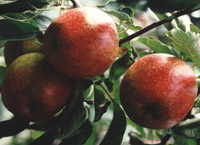 |
SALTCOTE
PIPPIN One of the best late dessert apples, raised at Rye in
Sussex, and believed to be a seedling of either Radford Beauty or Ribston
Pippin. It was first recorded in 1918. The medium to large, showy fruit
has crisp, juicy flesh and a rich aromatic taste, with a hint of parma
violets. It becomes sweeter with storage. Upright trees, which crop well.
Stores into January. Pollination Group 3 |
|||
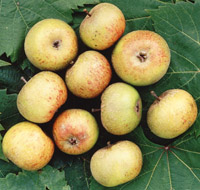 |
SAM
YOUNG An Irish apple known before 1818, from Kilkenny, introduced
by John Robertson, who had a nursery there. It was in the London Horticultural
Society catalogue of 1826. A small apple, roundish-oblate in shape, with
pale green-yellow skin which is nearly covered with grey russet and a
brown-red blush in the sun. The flesh is crisp, tender, juicy, sugary
and highly flavoured. Hogg adds it is ‘a delicious little dessert
apple of the first quality’. Ripe in October and storing to February.
Trees have a spreading habit. Pollination Group 3 |
|||
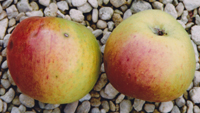 |
SANDLING
Known before 1936 when it was listed in the catalogue of Bunyard Nurseries,
Kent, though it originated in the West Country. A very late season dessert
apple, round, yellow skinned, striped and flushed with red. The flesh
is crisp, yellowish, juicy and sweet. It is ripe in late October and sometimes
as late as late November. Apples will last into the New Year. It has not
been known in Britain since 1952, but we noticed it in the United States
Department of Agriculture collection and obtained scions from them. Pollination
Group 5 |
|||
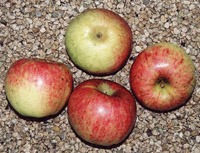 |
SANSPAREIL
A good dual purpose apple grown since the late nineteenth century. Small
to medium sized apples with green/yellow skin smartly striped red. Russet
in the stem cavity and eye basin. Crisp, juicy fruit, with a subtle honey
flavour, sometimes nutty, which keeps its shape if cooked, and has a sweet,
delicate flavour. Pretty blossom. Ripe in October, storing until March.
Heavy crops. Pollination Group 3 |
|||
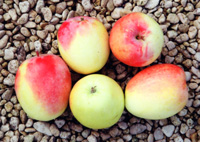 |
SARY SINAP This apple is thought to date from around 1790 but is probably earlier. It was in the first collection catalogue of the London Horticultural Society in 1826, as Saru Sinap, and still there in 1842, but apart from being in a list in Scott’s ‘The Orchardist’ in 1873, it has not been noted since in the UK. It still appears to be in the Roumanian collection and has been known in America (where we found it and brought it back) but it is unusually rare for such a good apple. This is one of several apples with ‘Sinap’ as part of the name and their origin has been attributed to Crimea, though it seems highly likely they arose in Sinop (formerly called Sinap) which is on a peninsula on the most northerly edge of Turkey, facing northwards to Crimea, just across the Black Sea. The Sinaps are usually quite long in shape. A very good eating apple, attractively streaked with red and with crisp, juicy, sweet flesh that has a rather unusual pleasant flavour, hinting of caramel. Ripe in early October, the apples will stay in good condition to the year end. Pollination Group 5 | |||
|
||||